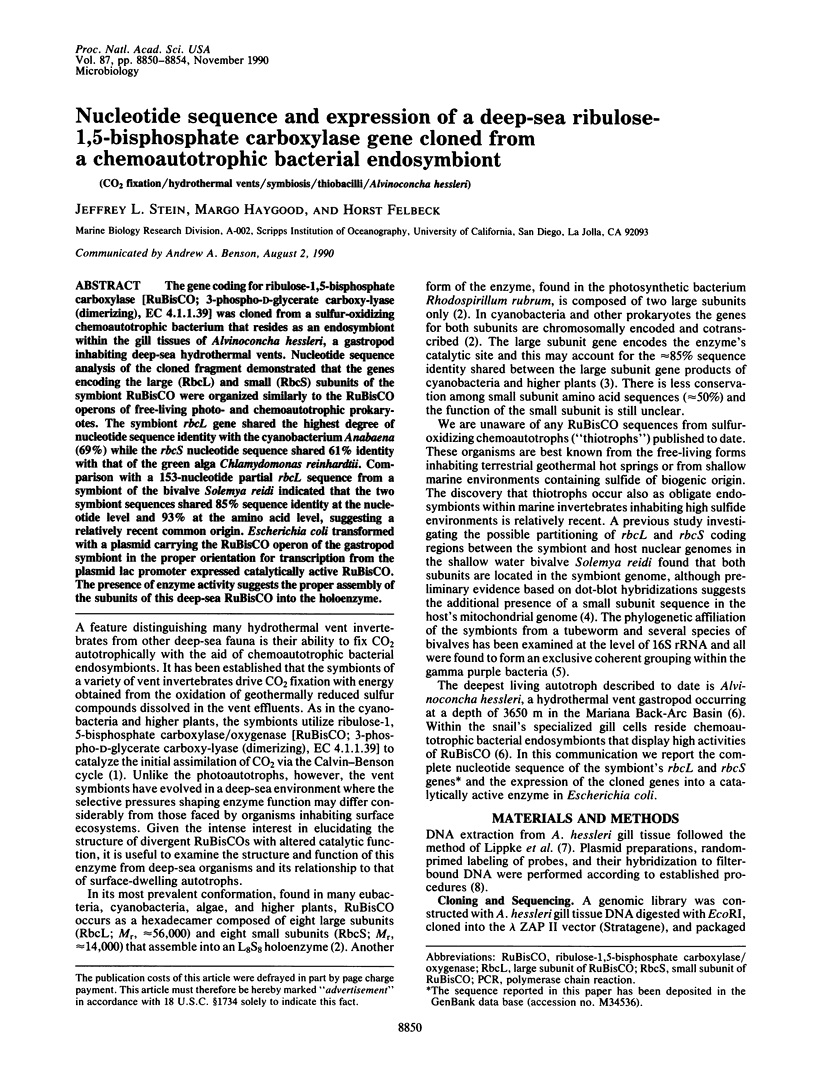Abstract
The gene coding for ribulose-1,5-bisphosphate carboxylase [RuBisCO; 3-phospho-D-glycerate carboxy-lyase (dimerizing), EC 4.1.1.39] was cloned from a sulfur-oxidizing chemoautotrophic bacterium that resides as an endosymbiont within the gill tissues of Alvinoconcha hessleri, a gastropod inhabiting deep-sea hydrothermal vents. Nucleotide sequence analysis of the cloned fragment demonstrated that the genes encoding the large (RbcL) and small (RbcS) subunits of the symbiont RuBisCO were organized similarly to the RuBisCO operons of free-living photo- and chemoautotrophic prokaryotes. The symbiont rbcL gene shared the highest degree of nucleotide sequence identity with the cyanobacterium Anabaena (69%) while the rbcS nucleotide sequence shared 61% identity with that of the green alga Chlamydomonas reinhardtii. Comparison with a 153-nucleotide partial rbcL sequence from a symbiont of the bivalve Solemya reidi indicated that the two symbiont sequences shared 85% sequence identity at the nucleotide level and 93% at the amino acid level, suggesting a relatively recent common origin. Escherichia coli transformed with a plasmid carrying the RuBisCO operon of the gastropod symbiont in the proper orientation for transcription from the plasmid lac promoter expressed catalytically active RuBisCO. The presence of enzyme activity suggests the proper assembly of the subunits of this deep-sea RuBisCO into the holoenzyme.
Full text
PDF




Images in this article
Selected References
These references are in PubMed. This may not be the complete list of references from this article.
- Andersen K., Caton J. Sequence analysis of the Alcaligenes eutrophus chromosomally encoded ribulose bisphosphate carboxylase large and small subunit genes and their gene products. J Bacteriol. 1987 Oct;169(10):4547–4558. doi: 10.1128/jb.169.10.4547-4558.1987. [DOI] [PMC free article] [PubMed] [Google Scholar]
- Andrews T. J., Ballment B. The function of the small subunits of ribulose bisphosphate carboxylase-oxygenase. J Biol Chem. 1983 Jun 25;258(12):7514–7518. [PubMed] [Google Scholar]
- Boczar B. A., Delaney T. P., Cattolico R. A. Gene for the ribulose-1,5-bisphosphate carboxylase small subunit protein of the marine chromophyte Olisthodiscus luteus is similar to that of a chemoautotrophic bacterium. Proc Natl Acad Sci U S A. 1989 Jul;86(13):4996–4999. doi: 10.1073/pnas.86.13.4996. [DOI] [PMC free article] [PubMed] [Google Scholar]
- Bradford M. M. A rapid and sensitive method for the quantitation of microgram quantities of protein utilizing the principle of protein-dye binding. Anal Biochem. 1976 May 7;72:248–254. doi: 10.1006/abio.1976.9999. [DOI] [PubMed] [Google Scholar]
- Chen E. Y., Seeburg P. H. Supercoil sequencing: a fast and simple method for sequencing plasmid DNA. DNA. 1985 Apr;4(2):165–170. doi: 10.1089/dna.1985.4.165. [DOI] [PubMed] [Google Scholar]
- Curtis S. E., Haselkorn R. Isolation and sequence of the gene for the large subunit of ribulose-1,5-bisphosphate carboxylase from the cyanobacterium Anabaena 7120. Proc Natl Acad Sci U S A. 1983 Apr;80(7):1835–1839. doi: 10.1073/pnas.80.7.1835. [DOI] [PMC free article] [PubMed] [Google Scholar]
- Devereux J., Haeberli P., Smithies O. A comprehensive set of sequence analysis programs for the VAX. Nucleic Acids Res. 1984 Jan 11;12(1 Pt 1):387–395. doi: 10.1093/nar/12.1part1.387. [DOI] [PMC free article] [PubMed] [Google Scholar]
- Distel D. L., Lane D. J., Olsen G. J., Giovannoni S. J., Pace B., Pace N. R., Stahl D. A., Felbeck H. Sulfur-oxidizing bacterial endosymbionts: analysis of phylogeny and specificity by 16S rRNA sequences. J Bacteriol. 1988 Jun;170(6):2506–2510. doi: 10.1128/jb.170.6.2506-2510.1988. [DOI] [PMC free article] [PubMed] [Google Scholar]
- Feng D. F., Doolittle R. F. Progressive sequence alignment as a prerequisite to correct phylogenetic trees. J Mol Evol. 1987;25(4):351–360. doi: 10.1007/BF02603120. [DOI] [PubMed] [Google Scholar]
- Fitchen J. H., Knight S., Andersson I., Branden C. I., McIntosh L. Residues in three conserved regions of the small subunit of ribulose-1,5-bisphosphate carboxylase/oxygenase are required for quaternary structure. Proc Natl Acad Sci U S A. 1990 Aug;87(15):5768–5772. doi: 10.1073/pnas.87.15.5768. [DOI] [PMC free article] [PubMed] [Google Scholar]
- Harley C. B., Reynolds R. P. Analysis of E. coli promoter sequences. Nucleic Acids Res. 1987 Mar 11;15(5):2343–2361. doi: 10.1093/nar/15.5.2343. [DOI] [PMC free article] [PubMed] [Google Scholar]
- Incharoensakdi A., Takabe T., Takabe T., Akazawa T. Heterologous hybridization of ribulose 1,5-bisphosphate carboxylase/oxygenase (RuBisCO) restores the enzyme activities. Biochem Biophys Res Commun. 1985 Jan 31;126(2):698–704. doi: 10.1016/0006-291x(85)90241-4. [DOI] [PubMed] [Google Scholar]
- Lippke J. A., Strzempko M. N., Raia F. F., Simon S. L., French C. K. Isolation of intact high-molecular-weight DNA by using guanidine isothiocyanate. Appl Environ Microbiol. 1987 Oct;53(10):2588–2589. doi: 10.1128/aem.53.10.2588-2589.1987. [DOI] [PMC free article] [PubMed] [Google Scholar]
- McFadden B. A., Torres-Ruiz J., Daniell H., Sarojini G. Interaction, functional relations and evolution of large and small subunits in Rubisco from prokaryota and eukaryota. Philos Trans R Soc Lond B Biol Sci. 1986 Oct 14;313(1162):347–358. doi: 10.1098/rstb.1986.0042. [DOI] [PubMed] [Google Scholar]
- Miziorko H. M., Lorimer G. H. Ribulose-1,5-bisphosphate carboxylase-oxygenase. Annu Rev Biochem. 1983;52:507–535. doi: 10.1146/annurev.bi.52.070183.002451. [DOI] [PubMed] [Google Scholar]
- Pretorius I. M., Rawlings D. E., O'Neill E. G., Jones W. A., Kirby R., Woods D. R. Nucleotide sequence of the gene encoding the nitrogenase iron protein of Thiobacillus ferrooxidans. J Bacteriol. 1987 Jan;169(1):367–370. doi: 10.1128/jb.169.1.367-370.1987. [DOI] [PMC free article] [PubMed] [Google Scholar]
- Raibaud O., Schwartz M. Positive control of transcription initiation in bacteria. Annu Rev Genet. 1984;18:173–206. doi: 10.1146/annurev.ge.18.120184.001133. [DOI] [PubMed] [Google Scholar]
- Shinozaki K., Sugiura M. The gene for the small subunit of ribulose-1,5-bisphosphate carboxylase/oxygenase is located close to the gene for the large subunit in the cyanobacterium Anacystis nidulans 6301. Nucleic Acids Res. 1983 Oct 25;11(20):6957–6964. doi: 10.1093/nar/11.20.6957. [DOI] [PMC free article] [PubMed] [Google Scholar]
- Tabita F. R. Molecular and cellular regulation of autotrophic carbon dioxide fixation in microorganisms. Microbiol Rev. 1988 Jun;52(2):155–189. doi: 10.1128/mr.52.2.155-189.1988. [DOI] [PMC free article] [PubMed] [Google Scholar]
- Tabita F. R., Small C. L. Expression and assembly of active cyanobacterial ribulose-1,5-bisphosphate carboxylase/oxygenase in Escherichia coli containing stoichiometric amounts of large and small subunits. Proc Natl Acad Sci U S A. 1985 Sep;82(18):6100–6103. doi: 10.1073/pnas.82.18.6100. [DOI] [PMC free article] [PubMed] [Google Scholar]



